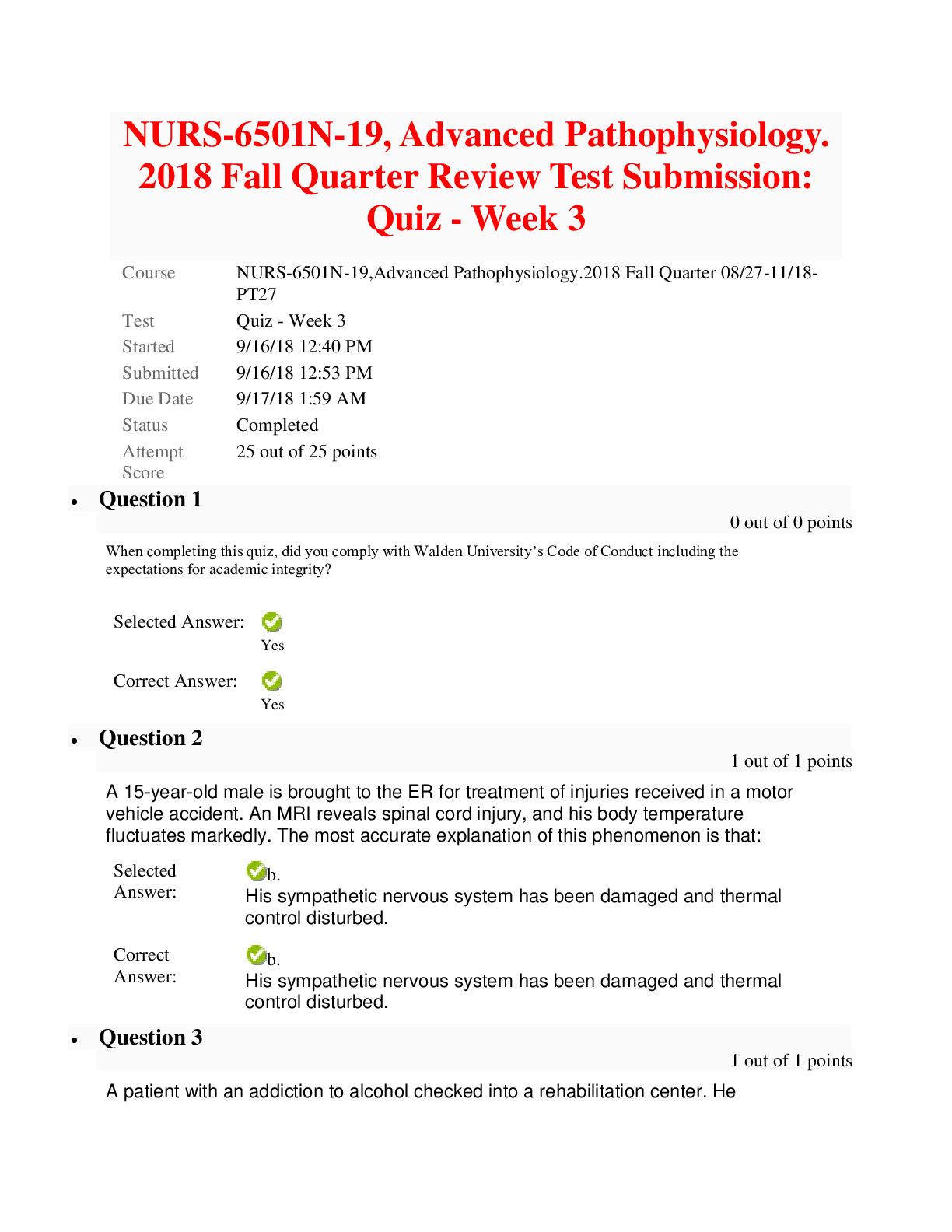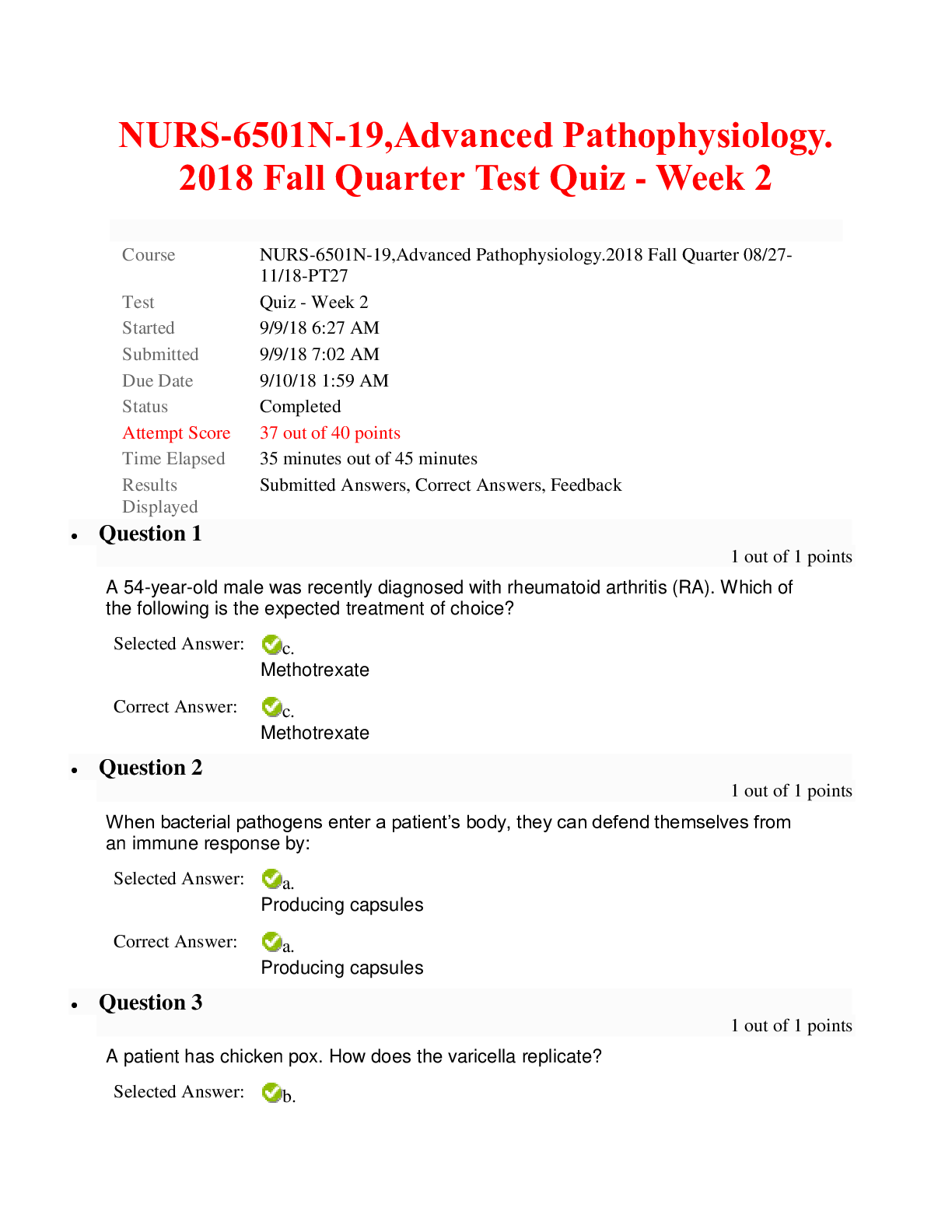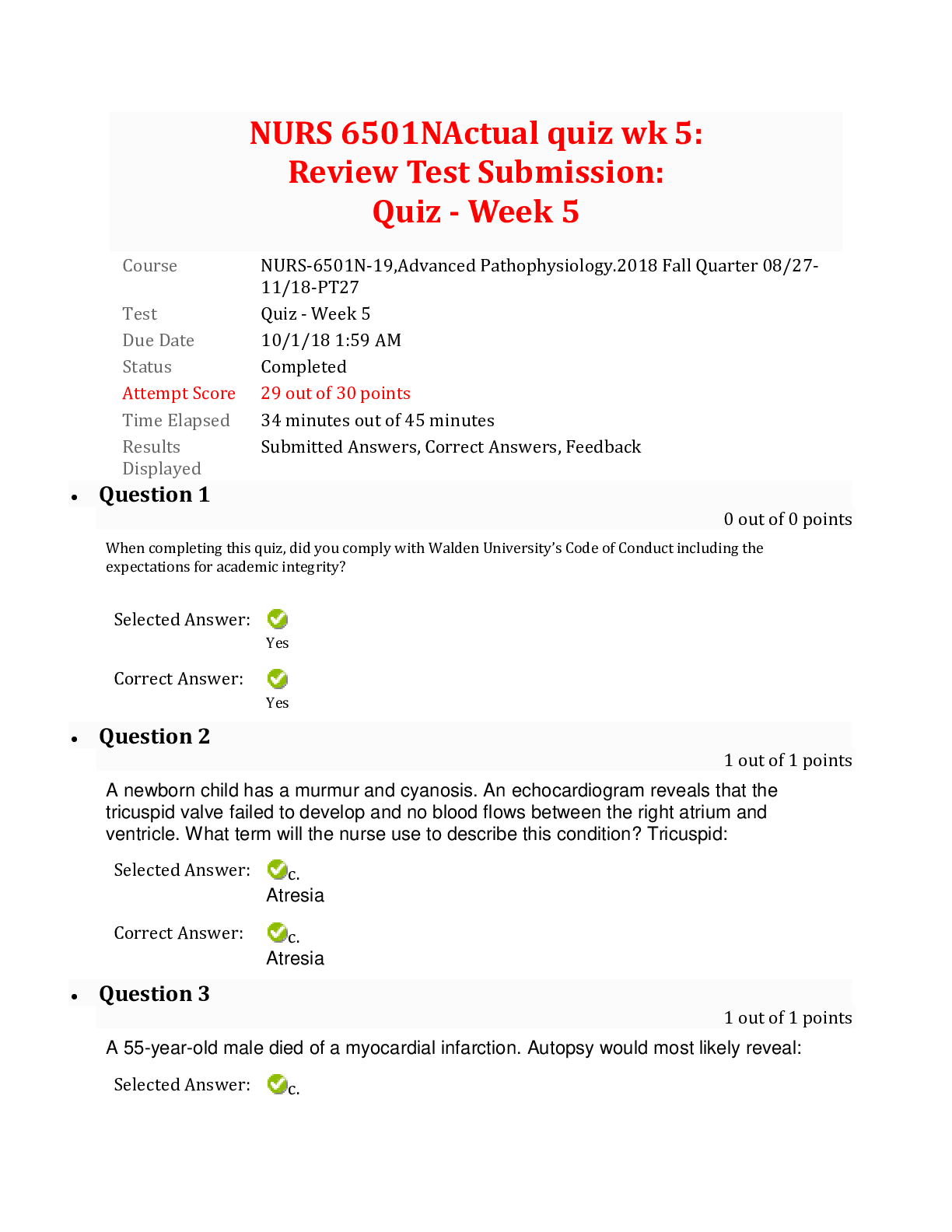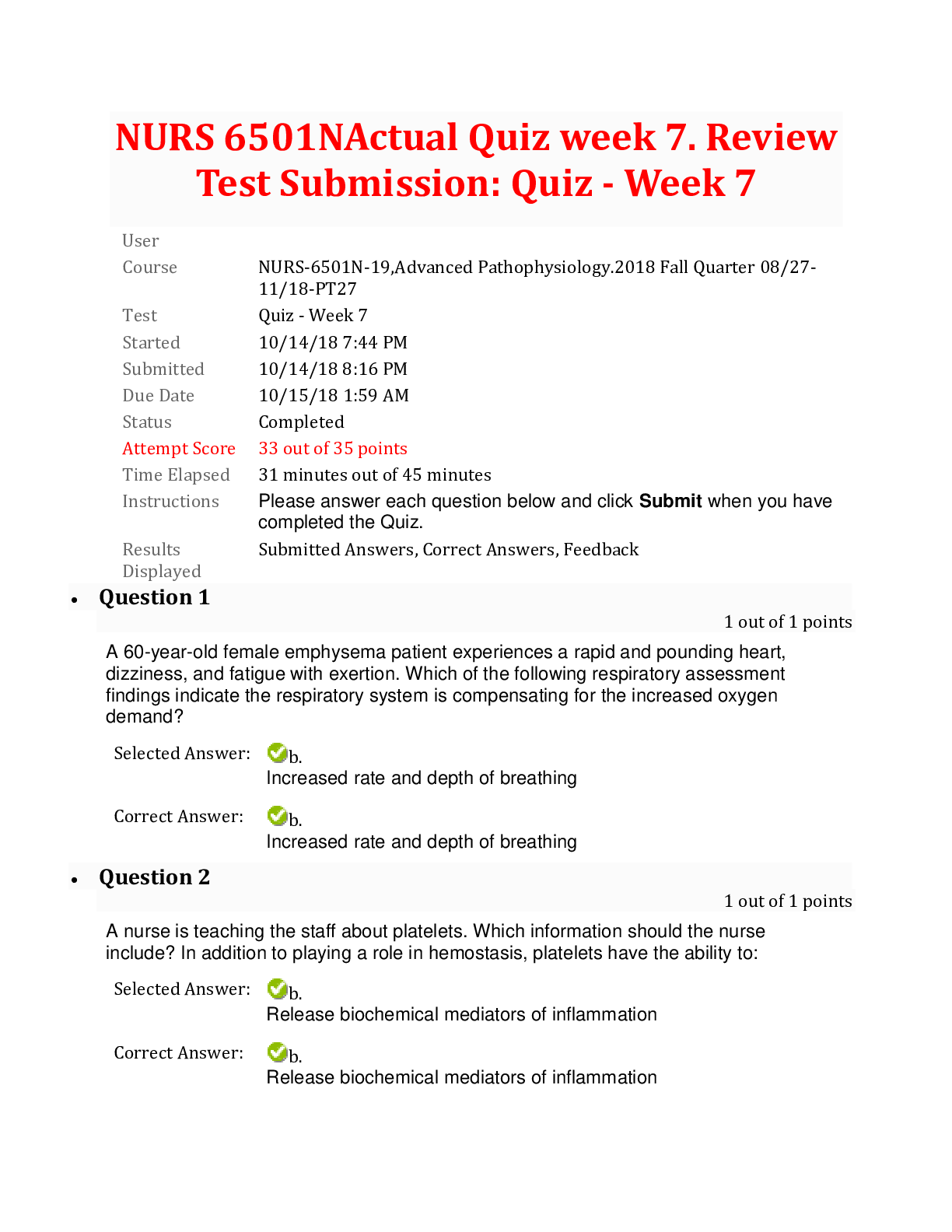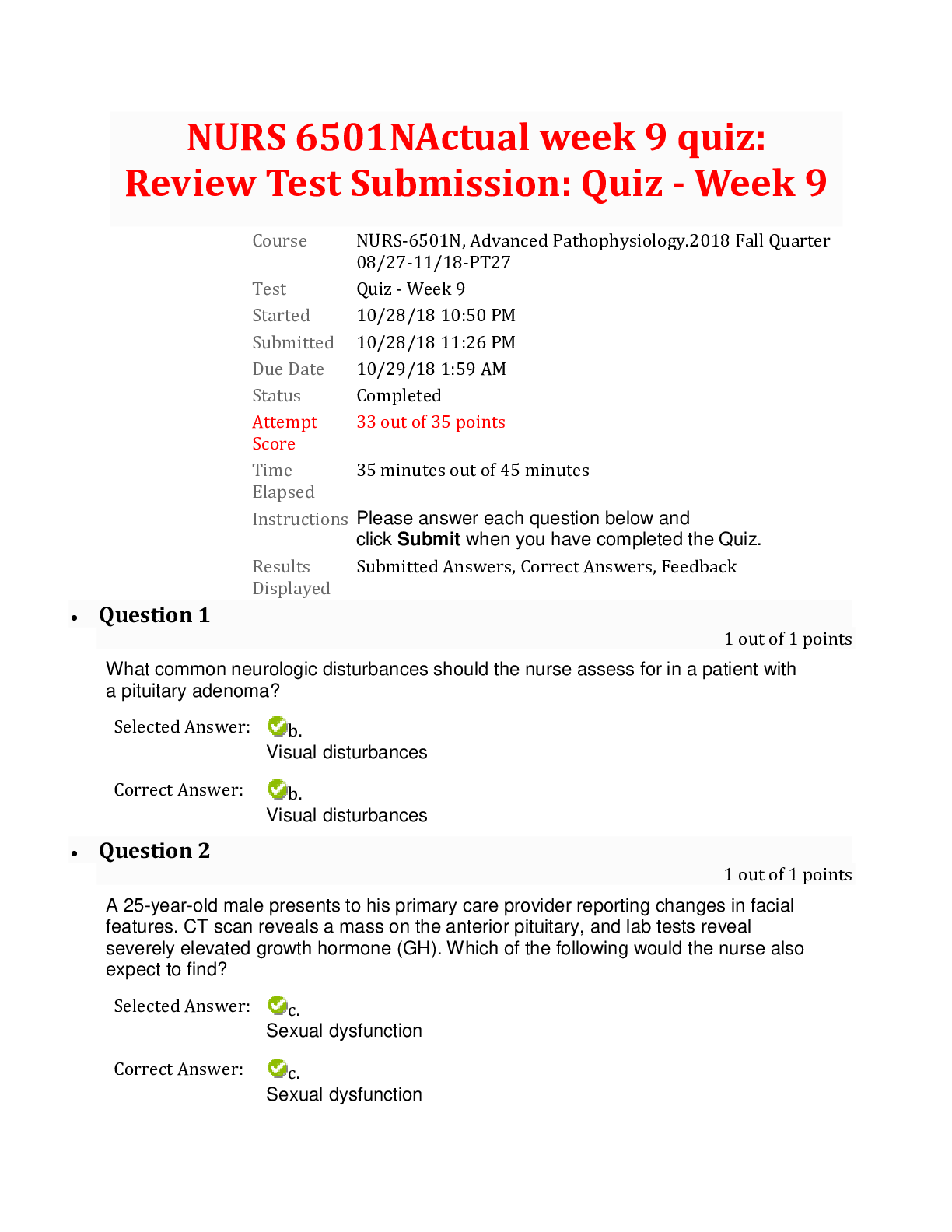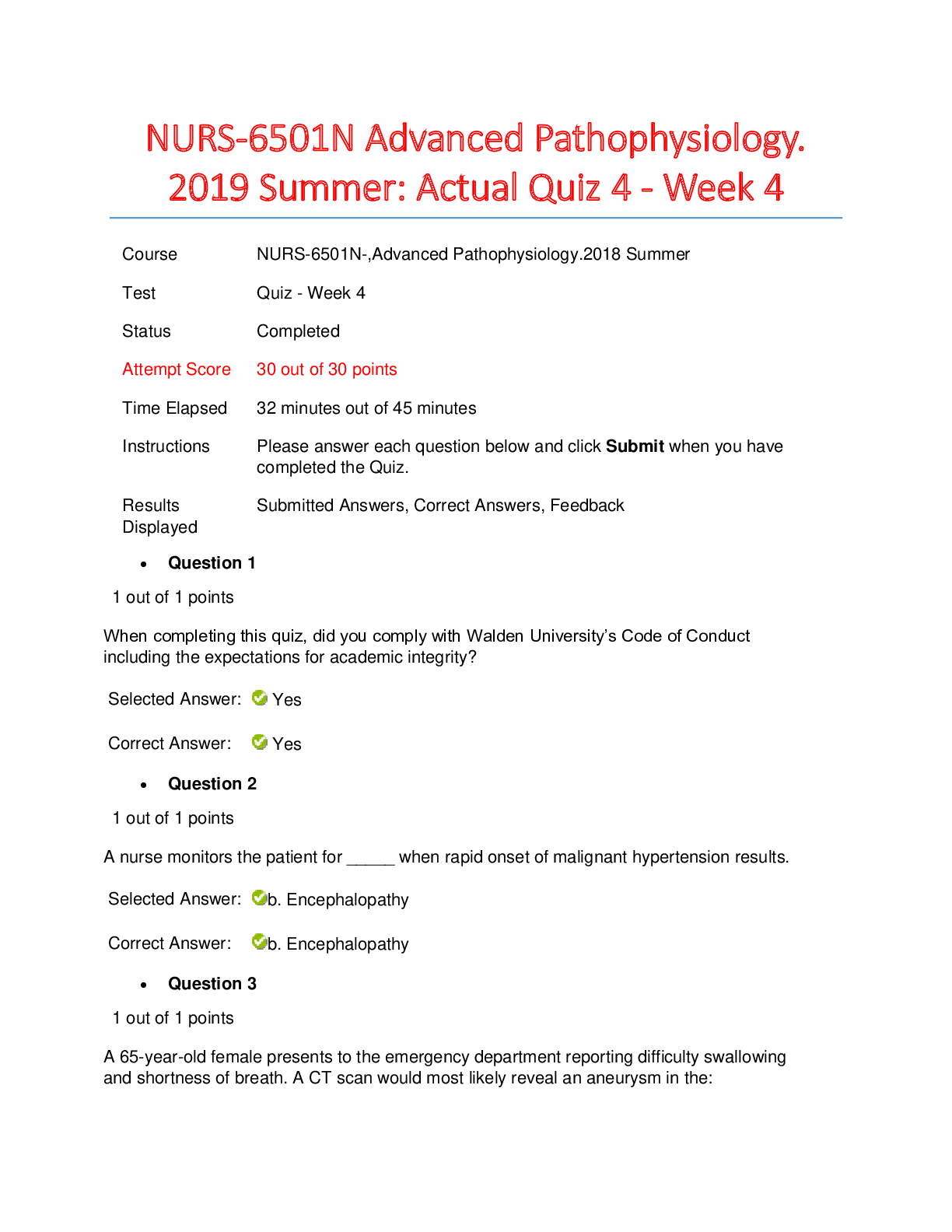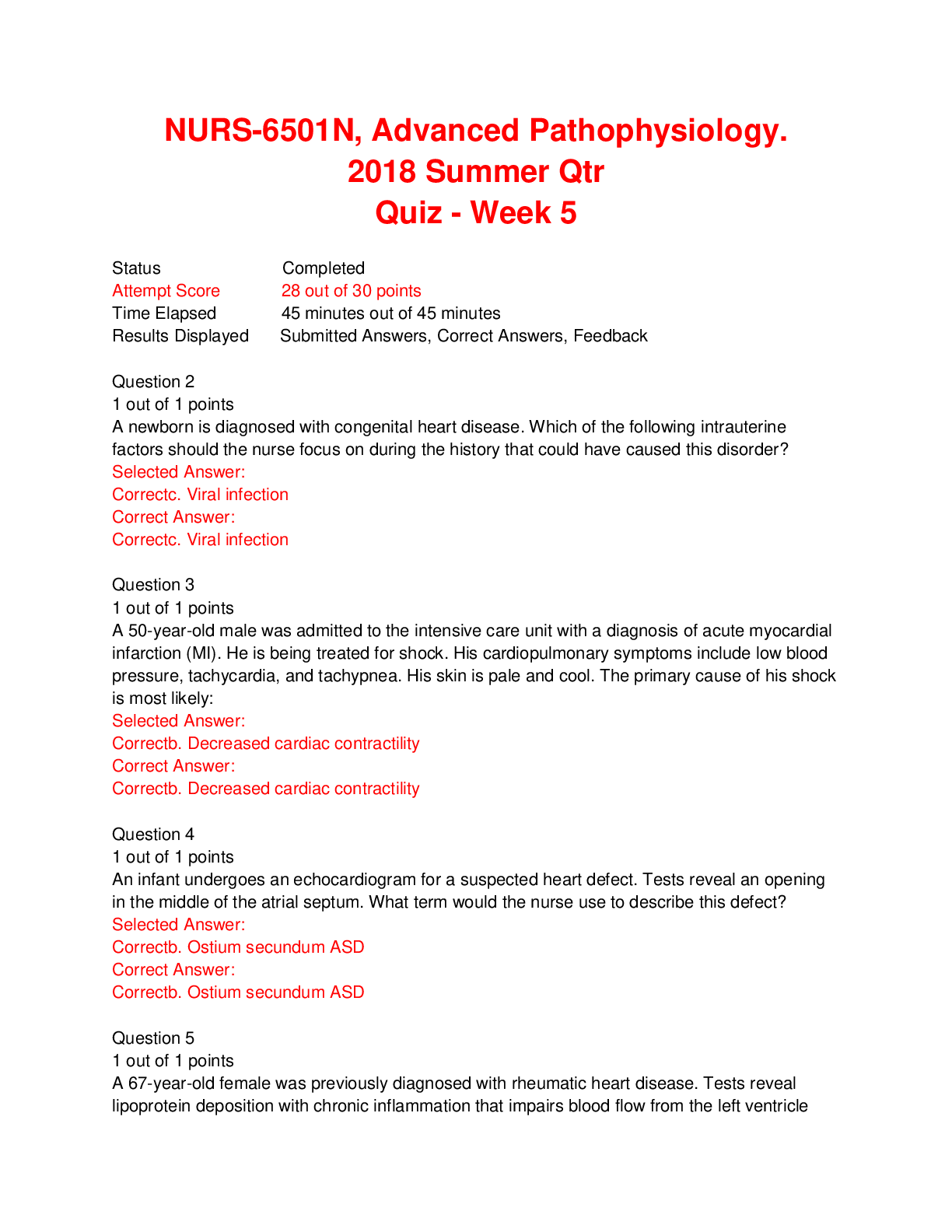*NURSING > QUESTIONS & ANSWERS > NURS-6501N-19, Advanced Pathophysiology. 2018 Fall Quarter Review Test Submission: Actual Quiz 6 - W (All)
NURS-6501N-19, Advanced Pathophysiology. 2018 Fall Quarter Review Test Submission: Actual Quiz 6 - Week 6 (Walden University). 100% Correct Answers.
Document Content and Description Below
NURS 6501N Actual quiz week 6. Review Test Submission: Quiz - Week 6 Course NURS-6501N-19,Advanced Pathophysiology.2018 Fall Quarter 08/27-11/18-PT27 Test Quiz - Week 6 Started 10/7/18 12:40 AM... Submitted 10/7/18 1:20 AM Due Date 10/8/18 1:59 AM Status Completed Attempt Score 28 out of 30 points Time Elapsed 40 minutes out of 45 minutes Instructions Please answer each question below and click Submit when you have completed the Quiz. Results Displayed Submitted Answers, Correct Answers, Feedback • Question 1 0 out of 0 points When completing this quiz, did you comply with Walden University’s Code of Conduct including the expectations for academic integrity? Selected Answer: Yes Correct Answer: Yes • Question 2 1 out of 1 points A 6-month-old female presents with rhinorrhea, cough, poor feeding, lethargy, and fever. She is diagnosed with bronchiolitis. Which of the following will the nurse most likely observe on the culture report? Selected Answer: c. Respiratory syncytial virus Correct Answer: c. Respiratory syncytial virus • Question 3 0 out of 1 points A 53-year-old male with a 20-year history of smoking is diagnosed with emphysema. When the nurse is asked what causes this, what is the nurse’s best response? Changes in his lungs are caused by: Selected Answer: b. Destruction of alveolar wall Correct Answer: c. Obstruction to heart tissue • Question 4 1 out of 1 points A 50-year-old male with a 30-year history of smoking was diagnosed with lung cancer. He was previously exposed to air pollution, asbestos, and radiation at his job. Which of the following should the nurse realize had the greatest impact on the development of his cancer? Selected Answer: b. Cigarette smoke Correct Answer: b. Cigarette smoke • Question 5 1 out of 1 points A 7-month-old male presents with cystic fibrosis (CF) accompanied by failure to thrive and frequent, loose, and oily stools. Sweat testing reveals increased chloride. Which of the following should the nurse observe for that would accompany this disease? Selected Answer: b. A thick mucus Correct Answer: b. A thick mucus • Question 6 1 out of 1 points While reviewing lab results, to help confirm a diagnosis of cystic fibrosis in a 1-year-old child which substance will be present in the child’s sweat? Selected Answer: b. Sodium chloride Correct Answer: b. Sodium chloride • Question 7 1 out of 1 points A 53-year-old male with a 20-year history of smoking is diagnosed with emphysema. When a staff member asks why the patient’s airways are obstructed, how should the nurse respond? The airways are obstructed because of: Selected Answer: b. Loss of elastic recoil Correct Answer: b. Loss of elastic recoil • Question 8 1 out of 1 points A nurse is preparing to teach the staff about asthma. Which information should the nurse include? Airway obstruction contributing to increased airflow resistance and hypoventilation in asthma is caused by: Selected Answer: c. Mucus secretion, bronchoconstriction, and airway edema Correct Answer: c. Mucus secretion, bronchoconstriction, and airway edema • Question 9 1 out of 1 points A 10-year-old male is brought to the ER with prolonged bronchospasm and severe hypoxemia. The most likely diagnosis on the chart is: Selected Answer: c. Status asthmaticus Correct Answer: c. Status asthmaticus • Question 10 0 out of 1 points A 25-year-old male presents with chronic bronchitis of 5 months’ duration. Which of the following is the most significant concern for the nurse to monitor in this patient? Selected Answer: b. Pulmonary embolus Correct Answer: d. Recurrent pulmonary infections • Question 11 1 out of 1 points A 60-year-old female with a 25-year history of smoking is diagnosed with emphysema. She has an increased anterior-posterior chest diameter. The nurse attributes this finding to: Selected Answer: a. Air trapping Correct Answer: a. Air trapping • Question 12 1 out of 1 points A nurse recalls asthma is classified by: Selected Answer: b. Clinical severity Correct Answer: b. Clinical severity • Question 13 1 out of 1 points A 9-year-old male contracted influenza. Which of the following complications is of greatest concern to the nurse? Selected Answer: b. Bronchiolitis obliterans Correct Answer: b. Bronchiolitis obliterans • Question 14 1 out of 1 points If an individual with respiratory difficulty were retaining too much carbon dioxide, which of the following compensatory responses would the nurse expect to be initiated? Selected Answer: a. Increase in respiratory rate Correct Answer: a. Increase in respiratory rate • Question 15 1 out of 1 points A 26-year-old female recently underwent surgery and is now experiencing dyspnea, cough, fever, and leukocytosis. Tests reveal that she has a collapsed lung caused by removal of air from obstructed alveoli. What condition will the nurse observe on the chart? Selected Answer: c. Absorption atelectasis Correct Answer: c. Absorption atelectasis • Question 16 1 out of 1 points An 11-year-old female presents with a low-grade fever and cough. She is diagnosed with atypical pneumonia. What type of pneumonia does the nurse suspect the patient is experiencing? Selected Answer: c. Mycoplasma pneumonia Correct Answer: c. Mycoplasma pneumonia • Question 17 1 out of 1 points A 20-year-old male presents to his primary care provider reporting difficulty breathing when lying down. What term should the nurse use to document this condition? Selected Answer: b. Orthopnea Correct Answer: b. Orthopnea • Question 18 1 out of 1 points A 13-year-old female is diagnosed with asthma. Which of the following should the nurse teach the patient to recognize as part of an asthmatic attack? Selected Answer: c. Wheezing Correct Answer: c. Wheezing • Question 19 1 out of 1 points A 50-year-old diabetic male did not take his medication and is now in metabolic acidosis. He is experiencing Kussmaul respirations. What type of breathing will the nurse observe upon assessment? Selected Answer: b. A slightly increased ventilatory rate, large tidal volumes, and no expiratory pause Correct Answer: b. A slightly increased ventilatory rate, large tidal volumes, and no expiratory pause • Question 20 1 out of 1 points A 65-year-old male recently had a cerebrovascular accident that resulted in dysphagia. He now has aspiration of gastric contents. The nurse assesses the patient for which complication? Selected Answer: a. Pneumonia Correct Answer: a. Pneumonia • Question 21 1 out of 1 points A 30-year-old male is involved in a motor vehicle accident and sustains trauma to the lungs and chest wall. He experiences respiratory failure. Which of the following lab values would the nurse expect? Selected Answer: b. Elevated PaCO2 Correct Answer: b. Elevated PaCO2 • Question 22 1 out of 1 points Which of the following shows a correct cause and effect sequence in the development of acute respiratory distress syndrome (ARDS)? Selected Answer: b. Alveolocapillary membrane injury causing a massive inflammatory response Correct Answer: b. Alveolocapillary membrane injury causing a massive inflammatory response • Question 23 1 out of 1 points A 42-year-old female presents with dyspnea; rapid, shallow breathing; inspiratory crackles; decreased lung compliance; and hypoxemia. Tests reveal a fulminant form of respiratory failure characterized by acute lung inflammation and diffuse alveolocapillary injury. Which of the following is the most likely diagnosis the nurse will observe on the chart? Selected Answer: a. Acute respiratory distress syndrome (ARDS) Correct Answer: a. Acute respiratory distress syndrome (ARDS) • Question 24 1 out of 1 points While planning care for a child with asthma, which of the following is characteristic of asthma? Selected Answer: b. Prolonged expirations Correct Answer: b. Prolonged expirations • Question 25 1 out of 1 points When the pulmonologist discusses the condition in which a series of alveoli in the left lower lobe receive adequate ventilation but do not have adequate perfusion, which statement indicates the nurse understands this condition? When this occurs in a patient it is called: Selected Answer: b. Alveolar dead space Correct Answer: b. Alveolar dead space • Question 26 1 out of 1 points A 65-year-old female with emphysema presents to the ER for difficulty breathing. Physical exam reveals bluish skin and mucous membranes. How should the nurse chart this condition? Patient has: Selected Answer: a. Cyanosis Correct Answer: a. Cyanosis • Question 27 1 out of 1 points A 22-year-old female presents with chronic bronchitis. Tests reveal closure of the airway during expiration. While planning care, a nurse recalls this condition is most likely caused by: Selected Answer: a. Thick mucus from hypertrophied glands Correct Answer: a. Thick mucus from hypertrophied glands • Question 28 1 out of 1 points A 60-year-old female with emphysema is having difficulty expiring a given volume of air. When giving report, the nurse will relay that the patient is most likely experiencing _____ pulmonary disease. Selected Answer: b. Obstructive Correct Answer: b. Obstructive • Question 29 1 out of 1 points A 14-year-old male is experiencing an asthma exacerbation. When reviewing the lab results, which of the following cells in the submucosa promote this inflammatory response and will be elevated? Selected Answer: b. Eosinophils Correct Answer: b. Eosinophils • Question 30 1 out of 1 points A 10-year-old female develops pneumonia. Physical exam reveals subcostal and intercostal retractions. She reports that breathing is difficult and she feels she cannot get enough air. What term should the nurse use to document this condition? Selected Answer: b. Dyspnea Correct Answer: b. Dyspnea • Question 31 1 out of 1 points When the nurse observes a diagnosis of nosocomial pneumonia, the patient generally acquires this pneumonia: Selected Answer: c. During hospitalization Correct Answer: c. During hospitalization Sunday, October 7, 2018 1:20:57 AM EDT [Show More]
Last updated: 1 year ago
Preview 1 out of 9 pages
Instant download
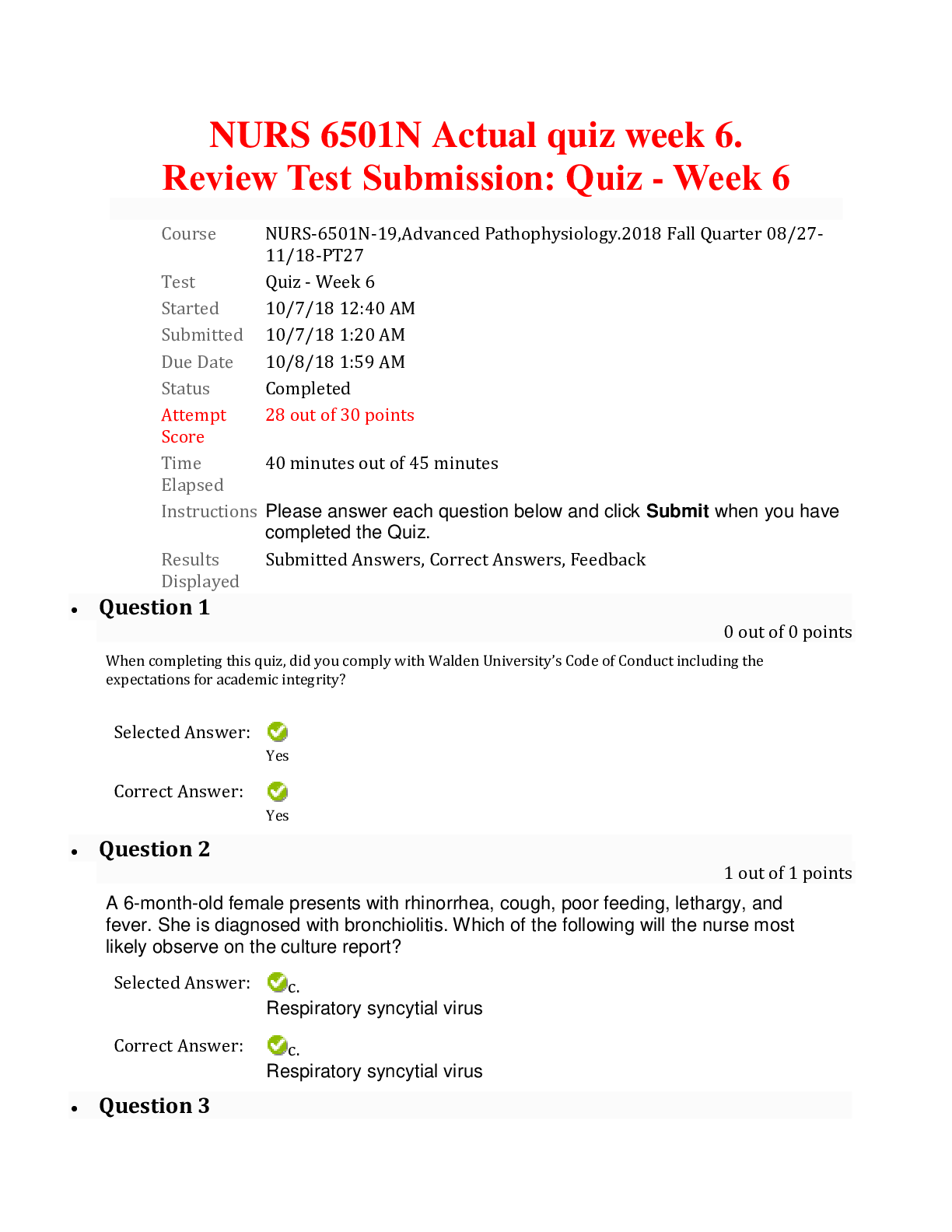
Buy this document to get the full access instantly
Instant Download Access after purchase
Add to cartInstant download
Reviews( 0 )
Document information
Connected school, study & course
About the document
Uploaded On
Jul 18, 2020
Number of pages
9
Written in
Additional information
This document has been written for:
Uploaded
Jul 18, 2020
Downloads
0
Views
37













